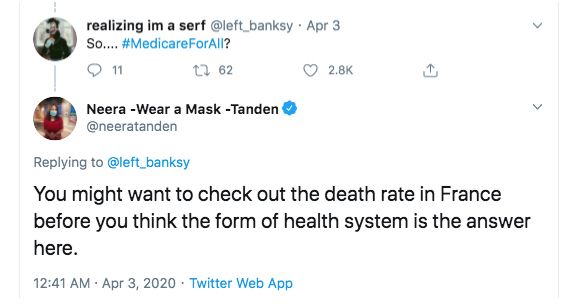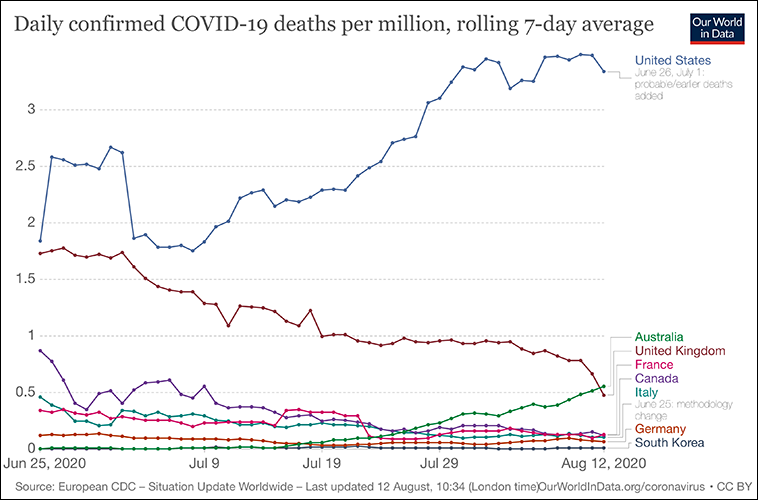This report was written by Walker Bragman.

When the novel coronavirus first arrived in the United States, it spurred on remarkable message discipline among America’s political class. The consensus that emerged on both sides of the aisle dictated that no matter what happened, Americans ought to be glad they do not live in a country with socialized medicine.
At the final Democratic presidential debate on March 15, former Vice President Biden pointed to COVID numbers in Italy as evidence that not only was Medicare for all not a solution to the crisis, but it would put the country at greater risk.
"With all due respect for Medicare for all, you have a single-payer system in Italy,” the former vice president said. “It doesn’t work there. It has nothing to do with Medicare for all. That would not solve the problem at all."
Weeks later, in early April, Center for American Progress president Neera Tanden echoed the sentiment in a Twitter spat with a Medicare for All supporter. “You might want to check out the death rate in France before you think the form of health system is the answer here,” she tweeted.
Not long after, the Washington Post ran an op-ed by former George W. Bush speechwriter Marc Thiessen declaring the COVID-19 pandemic was “an indictment of socialized medicine.”
“If you think today’s pandemic bolsters the case for socialized medicine, then ask yourself a simple question: If you came down with a serious case of COVID-19, would you rather be in an Italian hospital or an American one?” the piece opens, before lauding Biden’s debate answer.
Such arguments were never fair -- the pandemic was only just starting in the United States, while COVID-19 had indeed rampaged across Europe, there were contributing factors like years of austerity and a lack of supply chain redundancy in the modern globalized economy. But now, just a few months later, these arguments completely and utterly fail.
New infections are still surging in the U.S. while countries with national health care programs have long since gotten a handle on the virus. On Tuesday, the U.S. reported more new COVID cases in a single day than Italy, France, and the U.K. reported last month combined, and roughly 45 percent of their total deaths.
With 53,344 new cases and 1,450 deaths, Tuesday’s numbers were not extraordinary. There have been days with far higher counts on both statistics. But compared to the numbers coming out of Europe and elsewhere, they serve as a bleak reminder that America has completely failed to manage the pandemic. For the entire month of July, Italy reported just 6,959 new cases and 374 deaths; France reported 23,118 new cases and 434 deaths; the U.K. reported 19,424 new cases and 2,389 deaths.
In other words, it took the U.S. one average day to record more new cases and almost half the deaths that Italy, France, and the U.K. recorded in the month of July combined.

Polls Show Surging Support for Medicare For All
Outside of Europe, countries with national health care programs have also outperformed the United States.
Taiwan, which has single-payer, reported 20 new cases and no deaths in July.
New Zealand -- also a single-payer country -- declared itself COVID-free in early June. On Tuesday, it recorded its first locally-transmitted COVID case in 102 days.
The U.S. currently leads the world in active COVID cases with more than 5 million -- despite the fact that other nations are conducting more tests. Today, less than half of U.S. states are seeing a decline in infections. The U.S. also leads in the number of deaths with more than 162,000. The country represents just four percent of the planet’s total population but a stunning 25.5 percent of all COVID cases and 22 percent of all COVID deaths.
By comparison, according to the European Centre for Disease Prevention and Control, a body of the European Union, all of Europe, which has a population of 741 million, has about 3 million active cases and roughly 207,215 deaths since the pandemic started. All of Asia, with a population of 4.5 billion, has just over 4.8 million active cases and has seen roughly 106,711 deaths.
While much of the explosion in cases and deaths in the United States can be attributed to a premature push to reopen the country by the Trump administration and state governors, as well as the politicization of mask-wearing by the president and conservative activists, the pandemic has exposed gaps in America’s health care system that are impossible to ignore.
Public support for Medicare for all swelled in April according to the Koch-funded Pacific Research Institute, a think tank dedicated to “advancing free-market policy solutions.” A recent The Hill-HarrisX poll found that Medicare for all had the support of 87 percent of Democrats and 69 percent of independents. Indeed, even naysayers are beginning to change their tune.
Retweeting a call for Medicare for all by Rep. Ayanna Pressley (D-MA), MSNBC host Joy Reid, who has been a frequent critic of Bernie Sanders, acknowledged that while she’d been “a past M4A skeptic,” she couldn’t “think of one good reason today to keep the current system.” It’s a sentiment shared by many in the medical field.
Democratic Establishment Remains Opposed To Medicare For All
Even so, Biden has remained steadfast in his opposition to single-payer, which was not included in the recently released draft of the 2020 Democratic platform as a result. In response, 360 delegates have threatened to oppose the final platform if it does not include Medicare for All.
While the Democratic Party leadership battles things out with the base, many doctors are sounding the alarm, arguing the need for single-payer is urgent.
“Hospitals are now run as businesses and it doesn't make money to have empty beds, so ICUs and such are designed to be at 90-ish percent capacity to minimize loss,” explained Dr. Peter Possidente, a family medicine resident in upstate New York. “Not great when you have a massive surge of patients.”
To his point, New York experienced this problem of space in April. In mid-July, Florida, Arizona, and Texas hospitals struggled with the same problem.
Dr. Adam Gaffney — the president of Physicians for a National Health Program, a group that supports single-payer — said cost barriers to health care are making the crisis worse.
“The pandemic is laying bare the lethal inequality of American society and American health care,” he explained. “COVID-19 threatens the health of people everywhere, but only in the U.S. will it also ruin patients financially. When people avoid testing and care because they fear the costs, it fuels the epidemic’s spread.”
Gaffney’s point is not controversial. Back in April, World Health Organization Director-General Tedros Ghebreyesu encouraged all nations to remove cost barriers to care as a means of stemming the spread of the virus.
Possidente also echoed this warning, noting that health care rationing has left the U.S. population needlessly vulnerable to pandemics.
“Overall, if people have preventative and proactive health care, as opposed to just going when they’re on death’s door, they’ll be healthier and stand a better chance of surviving things when something does happen because they’ll be up to date on all the stuff that should have been done,” he explained. “Our population is not as healthy as it could be because it’s such a burden to have consistent medical care and medications in our system.”
Possidente worries that rationing will almost certainly be made worse with the recent surge in the number of uninsured Americans, a result of spiking unemployment as businesses let people go or fail altogether.
By May, an estimated 27 million Americans had lost their insurance plans, according to a report from the Kaiser Family Foundation.
According to a WestHealth/Gallup poll from late April, one in seven Americans said they would not seek treatment for COVID due to cost. Indeed, New York Governor Andrew Cuomo noted in May that 66 percent of people newly diagnosed with COVID were not seeking care. In cities across the country -- Houston, New York, Boston -- there have also been upticks in the number of Americans dying at home from coronavirus without seeking care. This trend, however, may reflect multiple causes including the late onset of the virus’s severe symptoms or fear by patients of contracting COVID at the hospital.
To solve the rationing problem and get COVID patients treatment, Congress has allocated billions in relief funding to hospitals and health care providers to cover free pandemic-related care. Meanwhile, large insurers like Aetna, Cigna, Humana, Blue Cross Blue Shield, UnitedHealthcare have made announcements waiving cost-sharing for COVID-related treatment -- even as they rake in record profits from people holding off on seeking care. As one recent headline put it, “Health insurers strike gold with COVID-19.”
UnitedHealth Group, for example, recorded its highest quarterly profit ever in the second quarter with a $6.6 billion haul. Even though the Affordable Care Act placed caps on health insurer profits and requires companies to pass any extra profits back to customers through rebates, companies are retaining their massive hauls.
Meanwhile, patients still face significant out of pocket expenses related to COVID treatment and testing. Last month, progressive California Rep. Katie Porter revealed that she had received a bill for $56.60 for a COVID test in addition to her $20 co-pay. Others have been less fortunate, facing charges of thousands of dollars.
This newsletter relies on readers pitching in to support it. If you like what you just read and want to help expand this kind of journalism, consider becoming a paid subscriber by clicking this link.




